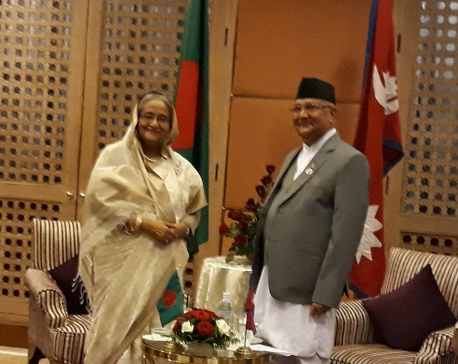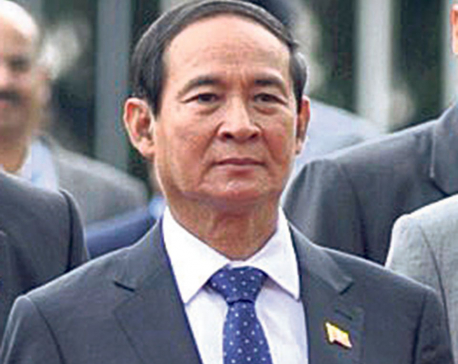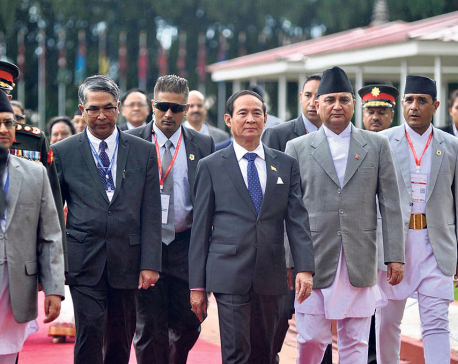
OR
Was Kathmandu BIMSTEC summit worth it? (with video)
Published On: September 6, 2018 03:15 PM NPT By: Roshan Sedhai
KATHMANDU, Sept 6: The fourth BIMSTEC summit held in Kathmandu last week marked a major shift in Nepal's foreign policy which could further dampen multilateral efforts to revive SAARC. That's the view of foreign policy experts who see BIMSTEC summit as “Kathmandu's endorsement of Indian line to promote BIMSTEC as an alternative to SAARC to further isolate Muslim countries in South Asia”.
Hours after Nepal concluded fourth BIMSTEC summit, Prime Minister KP Oli proclaimed that the summit was “successful in getting desired outcomes”, adding that it had opened doors to strengthen Nepal's economic and cultural ties with South East Asian countries.
But analysts said that the BIMSTEC summit was of lesser importance both in terms of agenda and achievement compared to the 18th SAARC summit held in Kathmandu four years ago although many of the common agendas put forth by its members have not been put through implementation due to growing standoff between India and Pakistan.
“BIMSTEC summit did help Prime Minsiter Oli and the ruling party to improve relations with India and other countries. But there was little to gain from the summit from Nepal's point of view. We should not ignore the fact that we don't even have connectivity or trades with more than half of BIMSTEC members,” said Surendra KC, professor of history at the Tribhuvan University.
SAARC and BIMSTEC might have similar agendas but both of them are unique organizations with huge potentials from Nepal's angle. But they can never be substitutes of one another. - -- Rajan Bhattarai, CPN leader and foreign policy analyst
Kathmandu, Dr KC argued, has now become the torchbearer of Indian design to promote BIMSTEC as an alternative to SAARC which he claimed was not possible for obvious strategic reasons.
“BIMSTEC cannot be an alternative of SAARC since it does not rightly reflect the religious diversity of the region we live in. It looks more like an amalgam of Hindu and Buddhist majority countries,” said KC, adding that the summit had proved too costly for Nepal in more than one way.
Nepal spent around Rs 2 billion to hold the BIMSTEC summit, according to estimates of senior officials at the Ministry of Finance (MoF). The money was spent on buying vehicles, to give a facelift to the city, host the foreign delegates and arrange their security during their Nepal stay. More than 25,000 security personnel from Nepal Army, Nepal Police, Armed Police Force and National Intelligence Department were mobilized during the summit. The security personnel were given a daily allowance of Rs 250.
Chandrakala Paudel, a spokesperson of the Ministry of Finance, said that her ministry was yet to receive the breakdown of the expenditure. She said that the ministries concerned including the Ministry of Foreign Affairs and the Ministry of Home Affairs had spent the money from the regular budget.
“Apart from Rs 20 million provided to the home ministry, the concerned ministries involved in preparation made all other expense from their regular budget,” said Paudel.
Despite contrary opinion of some experts, a few other analysts have expressed cautious optimism arguing that the summit was helpful in consolidating Nepal's relations with South East Asian countries.
“The summit was successful in narrowing down the priorities, strengthening the BIMSTEC secretariats and laying ground for a BIMSTEC charter. Nepal could benefit a lot from the show in the long run,” said Rajan Bhattarai, a foreign policy analyst and a leader of the ruling Communist Party of Nepal.
Bhattarai, however, claimed that Nepal takes a strong initiation to revive SAARC which has been a victim of the hostility between India and Pakistan.
“SAARC and BIMSTEC might have similar agendas but both of them are unique organizations with huge potentials from Nepal's angle. But they can never be substitutes of one another,” said Bhattarai.
You May Like This

PM Oli meets Bangladeshi PM
KATHMANDU, Aug 30: Prime Minister KP Sharma Oli has met visiting Bangladeshi Prime Minister Sheikh Hasina Wazed at a bilateral meeting... Read More...

Myanmar, Sri Lanka presidents to visit Lumbini
KATHMANDU, Aug 29: Myanmar President Win Myint will be visiting Lumbini Wednesday. Tourism Minister Rabindra Adhikari, Province 5 Governor Uma... Read More...

Dignitaries start arriving for BIMSTEC
KATHMANDU, Aug 29: Bhutan's Chief Advisor Dasho Tshering Wangchuk has arrived in Kathmandu to participate in the fourth BIMSTEC Summit.... Read More...






Just In
- Challenges Confronting the New Coalition
- NRB introduces cautiously flexible measures to address ongoing slowdown in various economic sectors
- Forced Covid-19 cremations: is it too late for redemption?
- NRB to provide collateral-free loans to foreign employment seekers
- NEB to publish Grade 12 results next week
- Body handover begins; Relatives remain dissatisfied with insurance, compensation amount
- NC defers its plan to join Koshi govt
- NRB to review microfinance loan interest rate











Leave A Comment